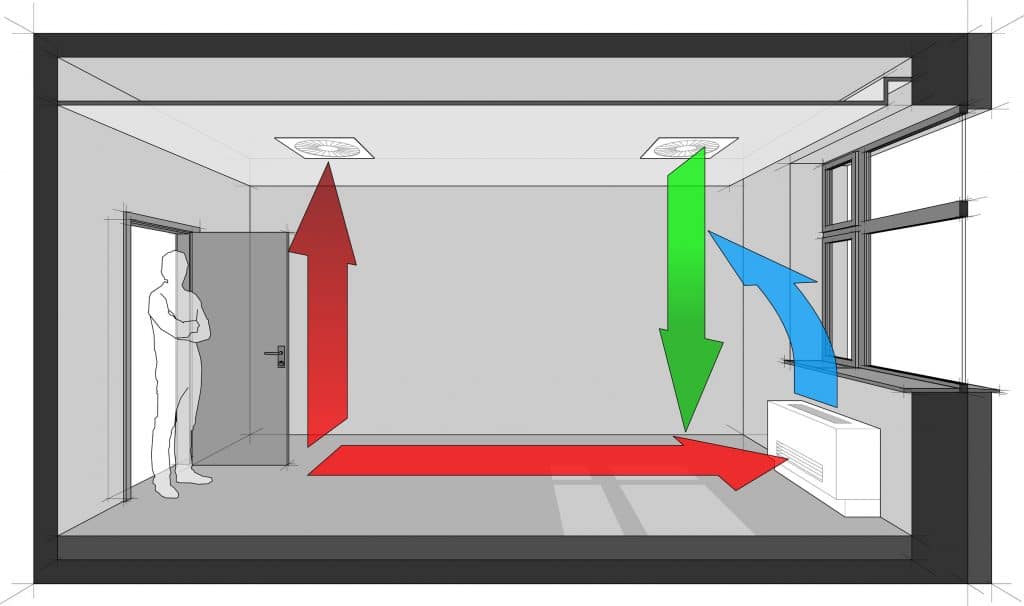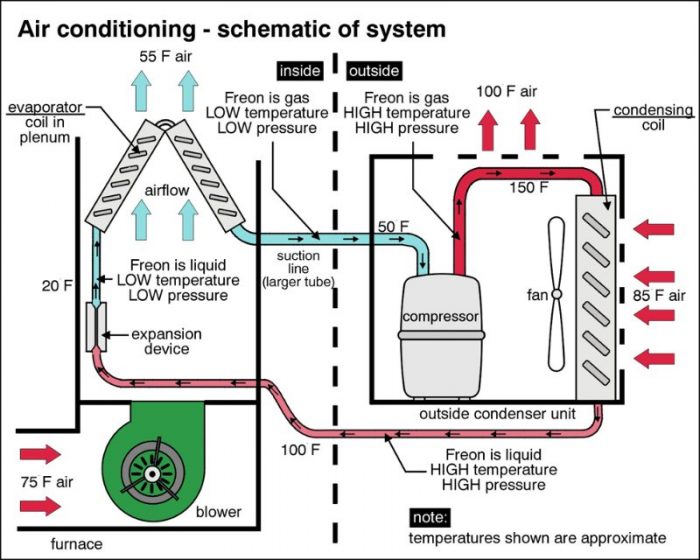How Does An Air Conditioner Work To Cool My Home

If you have air conditioning in your home, chances are you will not even bother to know how air conditioners work. You’re satisfied knowing that your air conditioner is functioning normally, preventing you from going crazy when the summer heat invades your home. At the back of your mind, you might think that an air conditioner works almost in the same way as your refrigerator since both appliances cool the air. There are similarities in terms of refrigeration, but the cooling method does not work in the same way. If you’re curious, look at the process of how air conditioners work to cool your home.
General Process of How Air Conditioning Works
Refrigeration principles are used by room and window air conditioners. These principles involve the extraction of heat and moisture from the air in the room, which is then cooled and dehumidified. Dehumidifying the room is one of the differences between a refrigerator and an air conditioner. The air conditioner dehumidifies the water vapor before it can condense around the cold parts of the air conditioner. The condensed water collects at the base pan (drip tray) and drains off through a hole fitted with a hose.
Inside an air conditioner unit are several components — fans or blowers to push cooled air into the room and exhaust the warm air in the room. The refrigerant parts extract the heat from the air inside the room. They comprise a compressor, tubing filled with refrigerant, condenser coil, and evaporator coil. Thermostat controls are also included.
Detailed Process Of How An Air Conditioner Works
The process of cooling a room is a cycle that is repeated several times when the air conditioner is turned on. Here is the step-by-step process of how air conditioners work:
- When the temperature in a room reaches the set point in the thermostat, it turns on the blower of the window or room air conditioner.
 This action draws the air in the room into the air inlet grille. A filter within will remove airborne particles and dust.
This action draws the air in the room into the air inlet grille. A filter within will remove airborne particles and dust. - The refrigeration process is initiated when the refrigerant is pumped through the tubing. The refrigerant changes into different states as it takes on and generates heat while raising and lowering the temperature. During this process, the refrigerant changes from liquid to gas to liquid once again.
- As the refrigerant moves through the indoor coil, it is in a very cold state. A blower moves the air along with the very cold coil, chilling it. As the chilled air is blown into the room, it changes the temperature from warm to cool. While circulating, it absorbs warm air that the blower pushes across the coil, changing it from its cold liquid state into vapor.
- The vapor goes to the compressor. The compressor then pressurizes the vapor and pushes it through the condenser coil. The heat contained is moved and released outside.
- The cycle ends with the refrigerant moving through an expansion device. This part converts the refrigerant into its cool liquid state once again. Its pressure also goes down as it goes back to the evaporator coil.
Combination Of Scientific & Mechanical Principles
The process of cooling your home is the same as the process of how a refrigerator keeps food cold. The only difference is that the refrigerator is an insulated space and it is small. A home air conditioner, on the other hand, cools larger spaces, such as a commercial, office, or home, keeping the temperature comfortable.
The process combines scientific and mechanical principles to ensure that your home is comfortably cool, not freezing.
The air conditioning unit uses chemicals. The system converts the chemical gas to liquid and back to gas again very quickly. The chemical process transfers the heat circulating inside and out of your home.
The main components of the air conditioning unit are its compressor, condenser, and evaporator. The evaporator is located inside the house, while the air conditioner’s compressor and condenser are usually located in the part of the air conditioning system that’s positioned outside of the house.
The cooling fluid or the refrigerant travels to the compressor in a low-pressure state. Inside the compressor, it squeezes the fluid or gas, forcing its molecules to be packed together very closely. As the compressor exerts more pressure, it raises the energy, and the temperature goes higher.
The fluid then goes out of the compressor as hot gas with high pressure. It travels to the condenser. The outside unit of the air conditioner contains metal fins located around its housing. The fins work like a vehicle’s radiator. They work to dissipate the heat quickly.
The liquid becomes cooler when it leaves the condenser. Moreover, the gas turns into liquid form due to the high pressure and passes through a small and narrow hole into the evaporator. When the liquid reaches the end of the small hole, its pressure drops, causing the fluid to evaporate as it turns back to gas.
As the process is happening, the heat from the surrounding air is removed. This heat separates the molecules of the liquid and turns them into gas. The metal fins located on the evaporator act to exchange thermal energy with the air in the surroundings.
From the evaporator, the refrigerant becomes a low-pressure cooled gas, and the process is repeated when the gas returns to the compressor. The fan that is connected to the evaporator circulates the air inside the home and over the evaporator’s fins.
If your air conditioner is an HVAC system, the air is sucked into the ducts through the vent. The sucked air cools the gas in the evaporator. When the heat is removed, it is cooled, and the ducts send the cooled air back into the home. The air conditioning system also has a dehumidifier, which removes the excess moisture in the air to prevent mold and mildew buildup.
The process is repeated until your home or office interior reaches the temperature you desire. Your air conditioning system has a thermostat. When it senses that the desired temperature inside the home or office is reached, it automatically shuts off the air conditioner. Once the room’s temperature goes higher, the thermostat restarts the air conditioner, and the cooling process is repeated.
The cooling process of an air conditioning system is automatic. You can ensure that your air conditioner works efficiently by proper and regular maintenance. Some parts require regular cleaning, the air filter needs replacing, and the mechanical parts require the services of a professional air conditioning technician.
Who To Call When Your Air Conditioner Is Not Cooling Your Home
This is how air conditioners work to cool your home. When you are in the market to install a new air conditioner or looking for a reputable air conditioning contractor for air conditioning system repair or maintenance, give Fischer Heating and Air a call. We have certified and licensed technicians to help you with your air conditioning needs. Tell us your air conditioner problems, and we’ll help you find the best solution. We at Fischer are ready to serve, ensuring that you will have a comfortable summer right here in Seattle.
Contact us for any additional questions you may have, or give us a call today at 206-202-9499.
